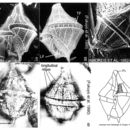Ecology
(
англиски
)
добавил NMNH Marine Dinoflagellates
G. polygramma is a planktonic species commonly found in neritic and oceanic waters (Steidinger & Tangen 1996). This cosmopolitan species is a red tide bloom former associated with shellfish and fish kills. Deadly G. polygramma red tides have been reported from Florida (Steidinger 1968), Japan (Nishikawa 1901; Fukuyo et al. 1990; Koizumi et al. 1996), New South Wales (Hallegraeff 1991), South Africa (Grindley & Taylor 1964), and Hong Kong (Lam & Yip 1990). During a bloom in Uwajima Bay, Japan, in 1994, cell levels peaked at 6.8 X 104 cell/ml and caused mass mortalities of cultured and natural fish and shellfish stocks (Koizumi et al. 1996).
- библиографски навод
- Faust, Maria A. and Rose A. Gulledge. Identifying Harmful Marine Dinoflagellates. Smithsonian Contributions from the United States National Herbarium, volume 42: 1-144 (including 48 plates, 1 figure and 1 table).
Habitat and Locality
(
англиски
)
добавил NMNH Marine Dinoflagellates
polygramma is a cosmopolitan species common in cold temperate to tropical waters worldwide (Hallegraeff 1991; Steidinger & Tangen 1996).
- библиографски навод
- Faust, Maria A. and Rose A. Gulledge. Identifying Harmful Marine Dinoflagellates. Smithsonian Contributions from the United States National Herbarium, volume 42: 1-144 (including 48 plates, 1 figure and 1 table).
Morphology and Structure
(
англиски
)
добавил NMNH Marine Dinoflagellates
G. polygramma is a photosynthetic species with chloroplasts. The large oval nucleus is located posteriorly (Dodge 1982).
- библиографски навод
- Faust, Maria A. and Rose A. Gulledge. Identifying Harmful Marine Dinoflagellates. Smithsonian Contributions from the United States National Herbarium, volume 42: 1-144 (including 48 plates, 1 figure and 1 table).
Nomenclatural Types
(
англиски
)
добавил NMNH Marine Dinoflagellates
Holotype: Gonyaulax polygramma Stein, 1883: pl. 4, figs. 15-16
Type Locality: unknown
- библиографски навод
- Faust, Maria A. and Rose A. Gulledge. Identifying Harmful Marine Dinoflagellates. Smithsonian Contributions from the United States National Herbarium, volume 42: 1-144 (including 48 plates, 1 figure and 1 table).
Reproduction
(
англиски
)
добавил NMNH Marine Dinoflagellates
G. polygramma reproduces asexually by binary fission.
- библиографски навод
- Faust, Maria A. and Rose A. Gulledge. Identifying Harmful Marine Dinoflagellates. Smithsonian Contributions from the United States National Herbarium, volume 42: 1-144 (including 48 plates, 1 figure and 1 table).
Species Overview
(
англиски
)
добавил NMNH Marine Dinoflagellates
Gonyaulax polygramma is an armoured, marine planktonic dinoflagellate species. It is a red tide bloom species associated with massive fish and shellfish kills.
- библиографски навод
- Faust, Maria A. and Rose A. Gulledge. Identifying Harmful Marine Dinoflagellates. Smithsonian Contributions from the United States National Herbarium, volume 42: 1-144 (including 48 plates, 1 figure and 1 table).
Taxonomic Description
(
англиски
)
добавил NMNH Marine Dinoflagellates
Gonyaulax polygramma are medium-sized cells, elongate and pentagonal (Figs. 1-6). The tapered epitheca bears a prominent apical horn, and exceeds the symmetrical hypotheca (Figs. 1-3). Longitudinal ridges ornament the thecal surface; reticulations are present between the ridges (Figs. 1-3). On mature cells, longitudinal ridges may be thick and spinulous. Cells range in size from 29-66 µm in length and 26-56 µm in dorso-ventral depth (Dodge 1982; Fukuyo et al. 1990; Hallegraeff 1991; Steidinger & Tangen 1996).
- библиографски навод
- Faust, Maria A. and Rose A. Gulledge. Identifying Harmful Marine Dinoflagellates. Smithsonian Contributions from the United States National Herbarium, volume 42: 1-144 (including 48 plates, 1 figure and 1 table).
Thecal Plate Description
(
англиски
)
добавил NMNH Marine Dinoflagellates
The plate formula for G. polygramma is: Po, 3', 2a, 6'', 6c, 4-8s, 6''', 1'''' (Dodge 1989). The epitheca is convex to angular, and bears 12 apical plates (Figs. 1-3). The elliptical apical pore plate (Po) does not extend onto the dorsal side of the cell; it is in direct contact with the first apical plate (1'). The 1' plate with a ventral pore (vp). The left-handed cingulum is post-median and displaced about 1.5 times its width without overhanging (Figs. 1, 2, 4, 6). The slightly excavated sulcus widens posteriorly; it invades the epitheca slightly (Figs. 1, 6). The hypotheca is truncate with straight sides and consists of six plates; 1-3 antapical spines present (Figs. 1-4, 6) (Dodge 1982; Fukuyo et al. 1990; Hallegraeff 1991; Steidinger & Tangen 1996).
- библиографски навод
- Faust, Maria A. and Rose A. Gulledge. Identifying Harmful Marine Dinoflagellates. Smithsonian Contributions from the United States National Herbarium, volume 42: 1-144 (including 48 plates, 1 figure and 1 table).
Toxicity
(
англиски
)
добавил NMNH Marine Dinoflagellates
G. polygramma is a non-toxin producing species, but as a red tide species, it has been associated with massive fish and invertebrate kills due to anoxia and high sulfide and ammonia levels resulting from cell decomposition (Hallegraeff 1991; Koizumi et al. 1996).
- библиографски навод
- Faust, Maria A. and Rose A. Gulledge. Identifying Harmful Marine Dinoflagellates. Smithsonian Contributions from the United States National Herbarium, volume 42: 1-144 (including 48 plates, 1 figure and 1 table).

